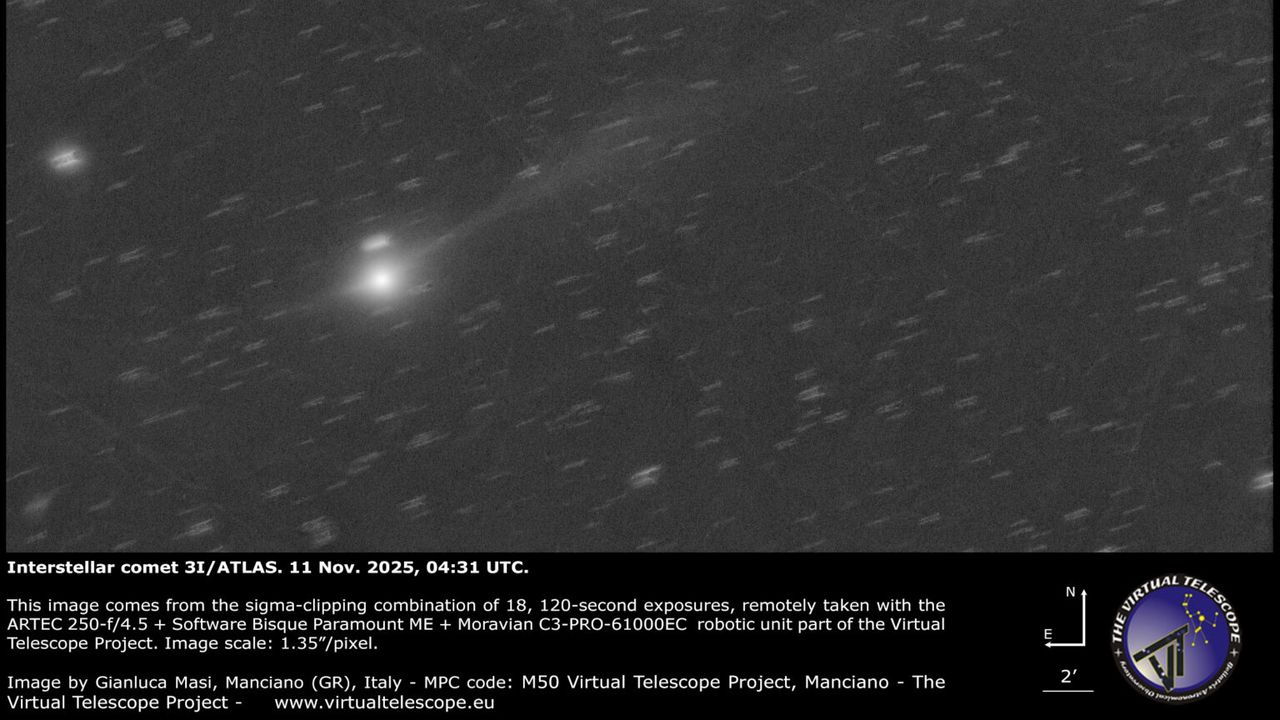Science
Interstellar Comet 3I/ATLAS Shows Remarkable Tail Growth

A recent image of interstellar comet 3I/ATLAS (C/2025 N1 ATLAS) reveals significant growth in its ion tail, indicating heightened activity as it traverses the inner solar system. Captured by the Virtual Telescope Project at 23:31 EDT on November 10, 2023 (04:31 GMT on November 11), the image demonstrates the comet’s tail has become longer and more structured. This visual data was compiled from 18 separate 120-second exposures taken by robotic telescopes based in Manciano, Italy.
The image showcases a clearly defined ion tail, despite the challenge posed by a bright 61% moon located approximately 70 degrees away. Gianluca Masi, the founder of the Virtual Telescope Project, noted the favorable weather conditions allowed for this detailed observation. “We imaged the interstellar comet 3I/ATLAS again, recording a much more developed ion tail,” Masi stated in a recent post. He emphasized that the tail’s clarity indicates increasing activity.
Understanding the Ion Tail
An ion tail forms when the sun’s ultraviolet radiation interacts with gas molecules released by the comet, stripping away electrons and converting them into charged ions. These ions are propelled away by the solar wind, creating a long, bluish tail that consistently points away from the sun, regardless of the comet’s trajectory. In contrast, the dust tail is typically yellowish-white and follows the comet’s orbital path.
In the newly captured image, the comet’s bright core is encircled by a compact coma, with the ion tail extending roughly 0.7 degrees across the sky. A faint anti-tail, resulting from the observer’s viewpoint as dust trails along the comet’s orbit, is also visible. The enhanced activity observed in this image suggests that 3I/ATLAS is releasing gas and dust more vigorously as it comes under the influence of solar heating.
Significance of 3I/ATLAS
Discovered in July 2023, 3I/ATLAS is only the third confirmed interstellar object detected, following 1I/’Oumuamua in 2017 and 2I/Borisov in 2019. Unlike its predecessors, this comet’s brightness allows for detailed study using ground-based telescopes, presenting a unique opportunity for astronomers to observe its behavior under solar influence.
The remarkable length and brightness of the ion tail suggest an increase in the sublimation of volatile materials, likely including carbon dioxide and dust. Early data indicates that 3I/ATLAS may contain a significant amount of carbon dioxide ice, providing potential insights into the conditions of the distant planetary system from which it originated. This could enhance our understanding of how comets evolve beyond our solar neighborhood.
The Virtual Telescope Project will continue to monitor 3I/ATLAS as it progresses through the inner solar system, offering valuable data for ongoing research into interstellar objects. For those interested, past images of the comet can be accessed, showcasing its journey since its detection earlier this year.
-

 Science3 weeks ago
Science3 weeks agoInventor Achieves Breakthrough with 2 Billion FPS Laser Video
-

 Health4 weeks ago
Health4 weeks agoCommunity Unites for 7th Annual Into the Light Walk for Mental Health
-

 Top Stories4 weeks ago
Top Stories4 weeks agoCharlie Sheen’s New Romance: ‘Glowing’ with Younger Partner
-

 Entertainment4 weeks ago
Entertainment4 weeks agoDua Lipa Aces GCSE Spanish, Sparks Super Bowl Buzz with Fans
-

 Business4 weeks ago
Business4 weeks agoTyler Technologies Set to Reveal Q3 Earnings on October 22
-

 Entertainment4 weeks ago
Entertainment4 weeks agoMother Fights to Reunite with Children After Kidnapping in New Drama
-

 Health4 weeks ago
Health4 weeks agoCurium Group, PeptiDream, and PDRadiopharma Launch Key Cancer Trial
-

 World4 weeks ago
World4 weeks agoR&B Icon D’Angelo Dies at 51, Leaving Lasting Legacy
-

 Entertainment4 weeks ago
Entertainment4 weeks agoRed Sox’s Bregman to Become Free Agent; Tigers Commit to Skubal
-

 Health4 weeks ago
Health4 weeks agoNorth Carolina’s Biotech Boom: Billions in New Investments
-

 Science4 weeks ago
Science4 weeks agoNorth Carolina’s Biotech Boom: Billions Invested in Manufacturing
-

 Top Stories4 weeks ago
Top Stories4 weeks agoFormer Mozilla CMO Launches AI-Driven Cannabis Cocktail Brand Fast









